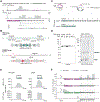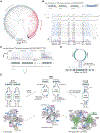TIGR-Tas: A family of modular RNA-guided DNA-targeting systems in prokaryotes and their viruses
- PMID: 40014690
- PMCID: PMC12045711
- DOI: 10.1126/science.adv9789
TIGR-Tas: A family of modular RNA-guided DNA-targeting systems in prokaryotes and their viruses
Abstract
RNA-guided systems provide remarkable versatility, enabling diverse biological functions. Through iterative structural and sequence homology-based mining starting with a guide RNA-interaction domain of Cas9, we identified a family of RNA-guided DNA-targeting proteins in phage and parasitic bacteria. Each system consists of a tandem interspaced guide RNA (TIGR) array and a TIGR-associated (Tas) protein containing a nucleolar protein (Nop) domain, sometimes fused to HNH (TasH)- or RuvC (TasR)-nuclease domains. We show that TIGR arrays are processed into 36-nucleotide RNAs (tigRNAs) that direct sequence-specific DNA binding through a tandem-spacer targeting mechanism. TasR can be reprogrammed for precise DNA cleavage, including in human cells. The structure of TasR reveals striking similarities to box C/D small nucleolar ribonucleoproteins and IS110 RNA-guided transposases, providing insights into the evolution of diverse RNA-guided systems.
Figures







References
-
- Makarova KS, Wolf YI, Iranzo J, Shmakov SA, Alkhnbashi OS, Brouns SJJ, Charpentier E, Cheng D, Haft DH, Horvath P, Moineau S, Mojica FJM, Scott D, Shah SA, Siksnys V, Terns MP, Venclovas Č, White MF, Yakunin AF, Yan W, Zhang F, Garrett RA, Backofen R, van der Oost J, Barrangou R, Koonin EV, Evolutionary classification of CRISPR-Cas systems: a burst of class 2 and derived variants. Nat Rev Microbiol 18, 67–83 (2020). - PMC - PubMed
-
- Hille F, Richter H, Wong SP, Bratovič M, Ressel S, Charpentier E, The Biology of CRISPR-Cas: Backward and Forward. Cell 172, 1239–1259 (2018). - PubMed
-
- Omer AD, Lowe TM, Russell AG, Ebhardt H, Eddy SR, Dennis PP, Homologs of small nucleolar RNAs in Archaea. Science 288, 517–522 (2000). - PubMed
MeSH terms
Substances
Supplementary concepts
Grants and funding
LinkOut - more resources
Full Text Sources
Research Materials

